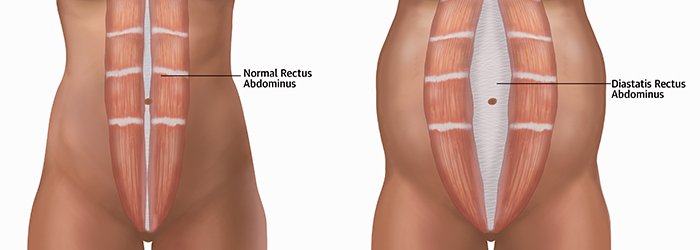Abdominal Separation in Pregnant and Postpartum Women: What Does It Mean and What Should I Do About It?
with Dr. Whitney Haase
If you’ve been pregnant yourself or have known a pregnant woman, then at some point you’ve probably heard about abdominal diastasis. While it’s not limited to pregnant and postpartum women (all newborn babies have it, and kids, women who have never had children, and adult men can all have it too), it’s probably talked about the most with pregnancy. There are a lot of misconceptions about what it means, why it happens, how it can affect movement, and how to treat it. So, we’re going to clear some of that up!
What is abdominal separation?
The rectus abdominus muscles are joined by the linea alba down the midline of the abdomen. The linea alba is connective tissue that helps to generate tension in the abdomen.
Photo credit: RMC Clinics
Diastasis, or separation of the front abdominal muscles, goes by a lot of different names: diastasis rectus abdominis (DRA), diastasis recti, abdominal separation, “mommy tummy,” etc. They’re all just a fancy way to say that your rectus abdominus or “six-pack” muscles have separated at the midline (linea alba). This isn’t necessarily a bad thing, and it’s actually completely normal during pregnancy. Our bodies were made to adapt to make room for a growing baby, and 100% of women will have a separation at the end of pregnancy!
Abdominal coning with an open diastasis, during a crunch exercise.
Image Credit: Kimberley Smith from Empowered Motherhood Program www.empoweredmotherhoodprogram.com.au
Why do the abdominal muscles separate?
As the baby grows, it causes increased pressure on the woman’s abdominal muscles. This increase in pressure causes the muscles at the front to separate at the linea alba. A lot of moms will get stressed about the separation and think there’s something wrong with them.
Don’t worry, this is totally normal. The muscles have to separate in order to make room for the growing baby — if they didn’t, then baby wouldn’t have enough room in the 2nd and 3rd trimesters!
After birth, a woman’s intra-abdominal pressure decreases, and typically the abdominal muscles will come back together within the first few months postpartum.
Abdominal coning/bulging with an open diastasis, in a pull-up position.
Photo credit: Katie Bacarella, PT, DPT - owner of MOVE Physical Therapy
How does having an abdominal separation affect my movement?
While the separation is present, women should be more aware of how they’re moving. Diastasis in pregnancy and immediately postpartum is normal, but it also makes it more difficult to stabilize the core.
To avoid widening the separation beyond what’s needed to make room for baby, pregnant women should avoid exercises that involve low back extension (arching of the low back), abdominal flexion (crunch-like activities), or a lot of core stabilization (like regular push-ups, pull-ups, etc.).
How do I know if an exercise is overstressing my separation?
Look for abdominal coning or bulging — it’s a great indicator that you are have too much pressure on the front of your core. If you see coning or bulging, try modifying the exercise you’re doing until the coning is no longer present instead of pushing through the exercise. A good example of this modification is replacing regular push-ups with standing push-ups against a wall or using a bench.
How is abdominal separation treated?
Most cases of abdominal separation can be treated with corrective exercises, working on optimizing how your core muscles are loaded, and improving your management of intra-abdominal pressure. Diastasis can be associated with symptoms like low back pain, pelvic pain, and incontinence, and a persistent separation is usually a good indicator that there is some degree of mismanaged abdominal pressure.
Specific exercises will depend on both the width and the depth of the separation as well as your stage in pregnancy or postpartum.
In my practice, I am much more concerned about the tension and function of the abdominal muscles and linea alba during movement than how wide a gap feels at rest or during an abdominal stress test.
The bottom line?
If you’re pregnant, a growing separation is a sign of a normal, healthy pregnancy. You should consider limiting exercises that cause abdominal coning during or after pregnancy, and see a perinatal movement specialist if you notice pain or a persistent separation several months after birth.
Dr. Whitney Haase is a perinatal chiropractor, certified BirthFit professional, and is trained in Herman & Wallace Pelvic Rehabilitation. She works with her patients to assess and treat abdominal separation in postpartum women, as well as help her pregnant patients prepare for birth.
Click the link below to schedule with Dr. Whitney Haase.



